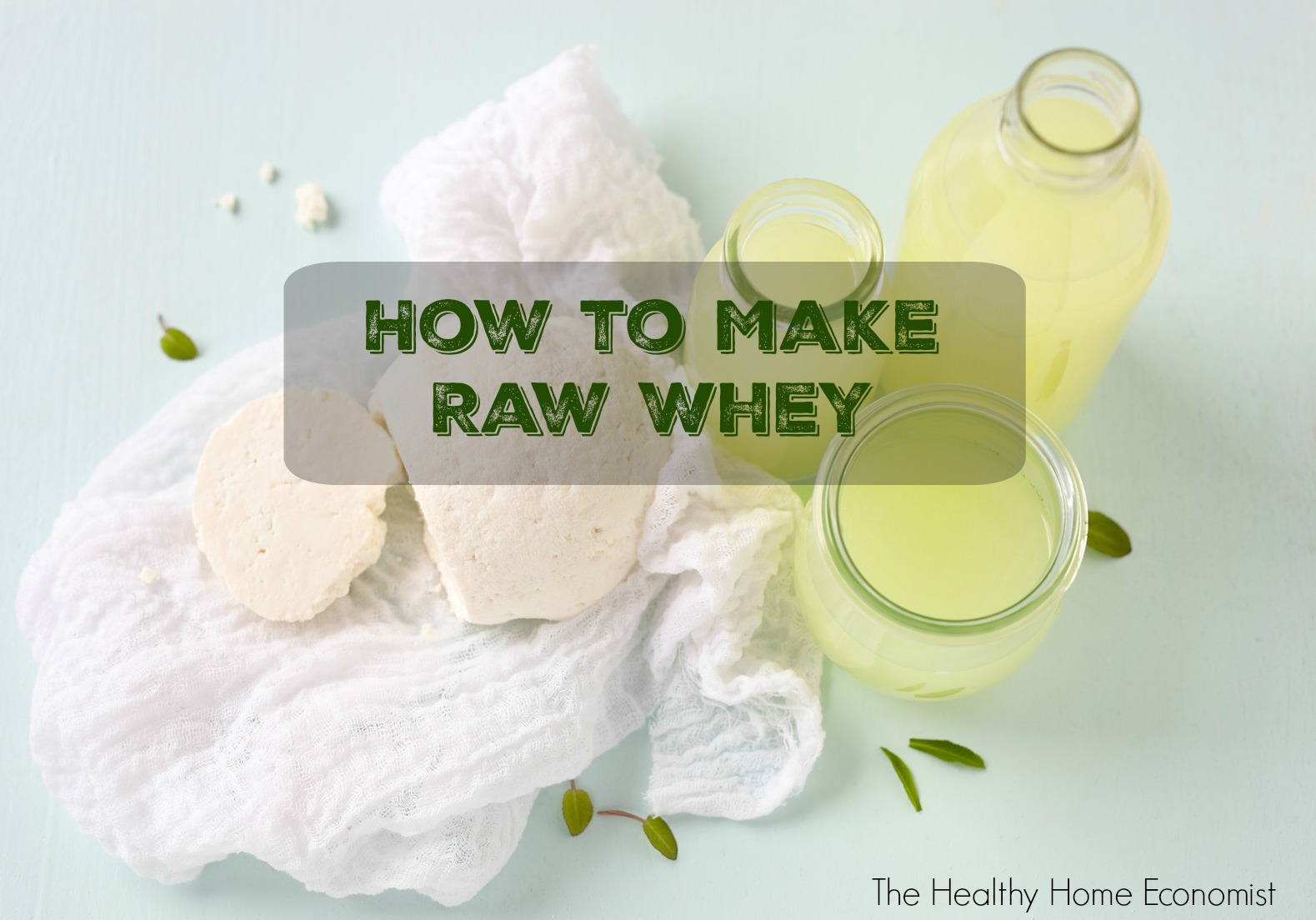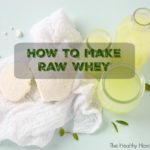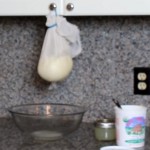How to make raw, enzyme and probiotic-rich liquid whey to use as a starter culture for all your home fermentation needs.

Do you know how to make whey from yogurt, kefir or raw milk?
A by-product of this simple technique is healthy homemade cream cheese that is loaded with enzymes and probiotics.
The recipe below describes how with visual instructions via video demonstration!
Making homemade baby formula? I recommend using this “quick whey” no straining method as the fastest and easiest approach.
How to Make Whey the REAL Way
Making real, liquid, nutrient rich, unadulterated whey in your own kitchen is a MUST step for any traditional cook to learn.
Without whey in its whole, liquid form, many other traditional recipes cannot even be attempted. You cannot buy whey from the store except in a denatured, unhealthy, powdered whey form. It is worth your time to learn what I show you in the video below.
Other video lessons on this blog show you how to use this whole food form of whey to make many delicious, healthful recipes for your family. Whey as made in the video demo below will keep up to 6 months in the refrigerator in a sealed mason jar.
If you absolutely have no access to farm fresh milk to make whole, unadulterated, enzyme rich whey, then you can use plain, organic yogurt brand from the store instead. Here are tips on how to spot the best yogurt brands.
The process is basically exactly the same thing as shown in the video.
You won’t get nearly as much whey using yogurt as clabbered, farm fresh milk, but at least you can get enough to get you started.
Wonderful Whey and REAL Cream Cheese
The raw, enzyme-rich cream cheese I make in the recipe video below is fantastic on a sprouted or sourdough bagel for breakfast. Don’t buy the Ezekiel sprouted muffins as they contain soy. This low-carb bagel recipe is another great one to try.
If you prefer to buy, these sourdough bagels are available for shipping freshly made to your door.
To make, just take your cream cheese left over from making liquid whey and add a few strawberries and a dash of dark maple syrup to taste. Mix together by pulsing a few times in your food processor. This wonderful, fresh, REAL strawberry cream cheese will last one to two weeks in the refrigerator. Another wonderful use for this healthy raw cheese is to make an easy no bake cheesecake.
No access to raw milk where you live? No problem. Check out this recipe plus video on how to separate whey from yogurt purchased from the store.
Cloudy Whey vs Clear Whey
No matter whether your whey turns out cloudy or clear, it is safe and fine to use in all your favorite recipes. This article explains why sometimes whey is cloudy compared to its usual golden color.

Raw Whey Recipe
How to separate raw, liquid whey from clabbered milk. The process also creates probiotic rich cream cheese.
Ingredients
- 1 quart raw milk preferably grassfed
- 1 large glass bowl
- 1 large rubber band
- 1 white dishtowel
Instructions
-
Allow the raw milk to sit on the counter for 1-3 days at room temperature.
-
When the milk separates into curds and whey (transforms into clabbered milk) you are ready to proceed. Note that the fresher the raw milk and the colder the temperature of your house, the longer it will take the raw milk to clabber.
-
Line a clean, large glass bowl with a clean, white dishtowel that isn’t too thick. Cheesecloth will also work, but the holes in the mesh must be very small, else the milk curds will pass through.
-
Gently pour the clabbered milk into the middle of the dish towel. Gather up the ends and fasten with a rubber band. Attach to a knob on an upper cabinet in your kitchen as shown in the picture.

-
Let the raw whey drip into the bowl underneath. This process will continue for an hour or two.
-
After the dripping stops, gently take down the hanging bag and place it into a clean bowl. Scrape out the raw cream cheese that is inside the bag, put in a container with a lid and refrigerate.
-
Pour the liquid whey from the dripping bowl into a glass mason jar, afix the lid and refrigerate.
-
Refrigerated, raw cream cheese will be good to eat for about a week. Raw whey will last several months refrigerated.
Recipe Video
How to Use Whey in Recipes
How to Make Ricotta Three Ways (plus Video How-to)
Perfect Probiotic Cottage Cheese
Cheese Making: Common Problems and Solutions








Thank you for the video! I am just about ready to make formula for our newborn. However, I live in Maryland where raw milk is illegal to sell. I buy milk from a local farm at the farmer’s market but it is still labeled as pasteurized and homogenized.
I know that you recommend not using powdered whey because it is typically denatured and processed. However, the only powdered whey I consume is non-denatured. Well Wisdom uses milk from organic Wisconsin cows and contains the “full range of all the fragile immune-modulating and regenerative components naturally present in fresh raw milk.”
Do you think this (unflavored, of course) would be acceptable?
Thank You!!
I have been making whey/cream cheese with Stoneyfield organic cultured pasteurized whole milk plain yogurt for a few years now. It turns out great. Is “cultured pasteurized” okay? If not, what would you suggest other than farm fresh milk? Thank you so much.
Sarah – If I make the whey using cheese cloth it seems to be much more cloudy than if I use a tea towel. Is it ok to have the whey be cloudy? I am using the whey to make the homemade formula recipe. Thanks so much!
Sweet Sarah! This is my second week of my cow share and “Nourishing Traditions” is why. Your video made making whey super simple for me. Thanks a bunch!
I want to be just like you ! 🙂
Sarah, so grateful for the video and your answers to the questions. This makes it easier to risk failure with this new/old way of cooking.
Hi there – I’ve also heard that ‘raw’ milk doesn’t go bad. However there’s a difference between something being left to decompose and controlled fermentation. Being a naturally thrifty person, I have a big problem with throwing something away (old milk, stock that I’ve burned, a cake that I’ve over-salted), but the bottom line is – if its been left to go off, and smells off, then bite the bullet and throw it away. Yoghurt, or clabbered milk, isn’t bad and if you regularly use yoghurt and eat unpasteurised ‘smelly’ cheese, you are likely to know the difference in smell and taste between fermented and decomposing. When I ferment milk (clabber) it, then I do everything in a timely manner – fermenting something isn’t a way to use up milk that’s hung around for a long time. Its a good idea to become used to the smell and taste of unpasteurised products before making your own – I also had a problem with this, because such items are expensive. But if you don’t know what something should taste like, you don’t know if you’ve succeeded in doing it right. But, once again, the bottom line is that if it tastes nasty, throw it away and try again.
Hi Sarah,
Do you know if the whey is the same as the whey you would buy in a protein drink? Obviously the homemade whey is much better for you, but does it have the same protein qualities?
Thanks!
Hi Sarah,
It seems a lot of people have similar questions in regard to the age of the milk, as well as the taste of the cheese. I would very much appreciate it, if you could take a moment to answer us, so we know if we did something wrong, or if that’s the way it’s supposed to be…
thank you
I tried making cream cheese and whey using the instructions on the video and thought it, the cheese, did not tasted good at all. It smelled like baby spit-up. The raw milk I used had been in the fridge for at least a month. Did it’s age give the cheese a stronger taste, or is it just an aquired taste? If it’s acquired, I don’t think I can do it. Disappointed because I was so excited about not wasting the milk. Ended up wasting it and my organic strawberries:-(
Why can’t you use whey from pasteurized milk inoculated with lacto bacteria from a yogurt?